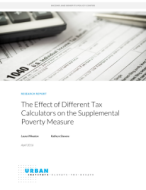
An official website of the United States government
Here’s how you know
Official websites use .gov
A .gov website belongs to an official government organization in the United States.
Secure .gov websites use HTTPS
A lock (
) or https:// means you’ve safely connected to the .gov website. Share sensitive information only on official, secure websites.
-
//
- Census.gov /
- Library /
- Census Working Papers /
- The Effect of Different Tax Calculators on the SPM
The Effect of Different Tax Calculators on the Supplemental Poverty Measure
The Effect of Different Tax Calculators on the Supplemental Poverty Measure
Introduction
Federal and state income taxes are an important component of the Supplemental Poverty Measure (SPM). Positive tax liability counts as an expense when calculating the SPM and so it moves some workers (primarily those without children) into poverty or near-poverty. In contrast, refundable tax credits, including the earned income tax credit (EITC) and the refundable portion of the child tax credit, increase family resources and are important antipoverty policies for families with children.
Since taxes are not directly reported on the Current Population Survey (CPS) Annual Social and Economic Supplement (ASEC), the Census Bureau calculates payroll taxes and federal and state income taxes using its own internal model. Maintaining and updating a tax model annually is labor intensive, especially when state income taxes are included. The current tax model used by the Census Bureau was developed in-house and requires substantial staff effort to keep up to date. The annual updates for policy changes in a model as complex as an accurate tax imputation model must be require expertise and labor input that may not be available in-house. Maintaining in-house expertise with the tax model can also be challenging as staff members move on to other positions or projects.
In light of these challenges, some experts have recommended that the Census Bureau use the National Bureau of Economic Research (NBER) TAXSIM model to calculate taxes. Another possibility would be to use the tax model developed by Dr. Jon Bakija of Williams College, which is currently being used by the Urban-Brookings Tax Policy Center for state income tax modeling. Both models have been provided to the Census Bureau and could be run in-house.
This paper compares the results of the Census Bureau’s tax model with results generated by the TAXSIM and Bakija models and shows how differences in tax estimates affect the SPM. To provide additional context, the results are also compared with results from the Transfer Income Model Version 3 (TRIM3), a comprehensive microsimulation model developed and maintained by the Urban Institute with primary funding from the Department of Health and Human Services Office of the Assistant Secretary for Planning and Evaluation (ASPE).
Share
Related Information
WORKING PAPER
Supplemental Poverty Measure Working PapersSome content on this site is available in several different electronic formats. Some of the files may require a plug-in or additional software to view.
 Yes
Yes
 No
NoComments or suggestions?


Top

